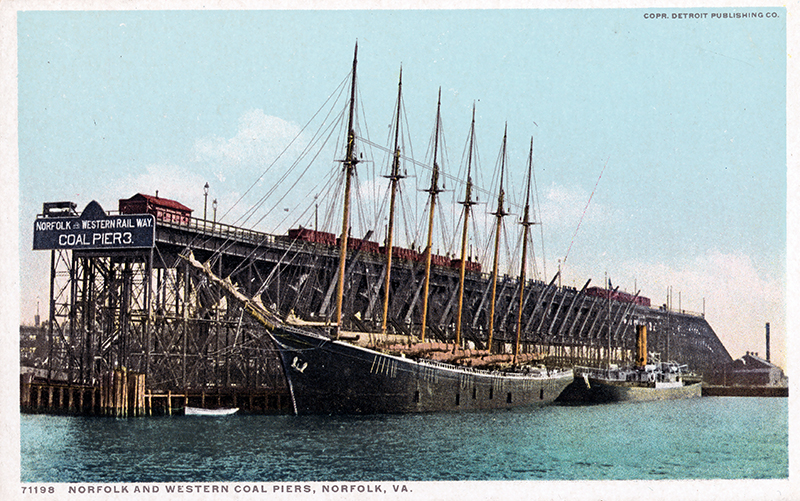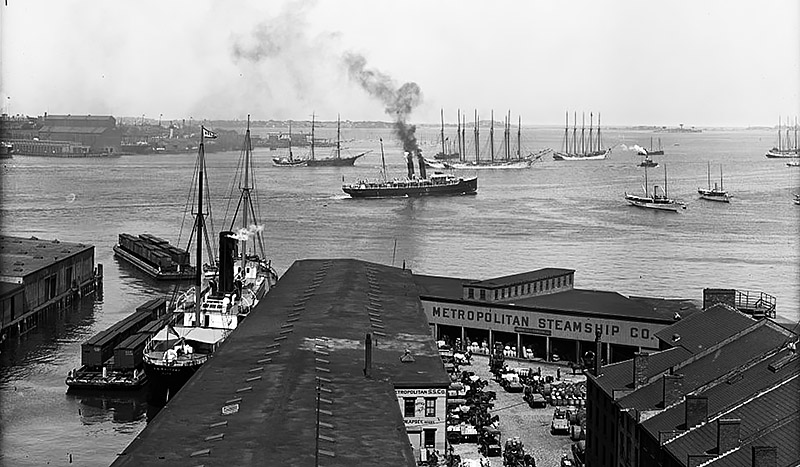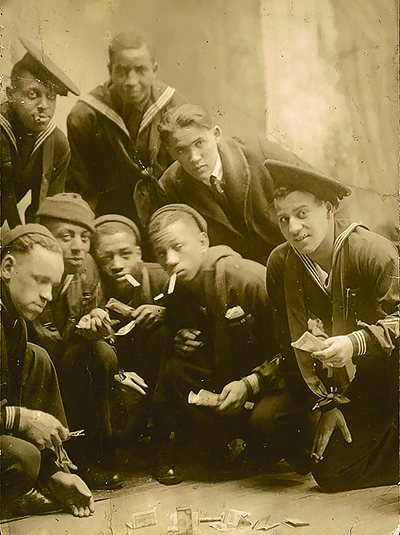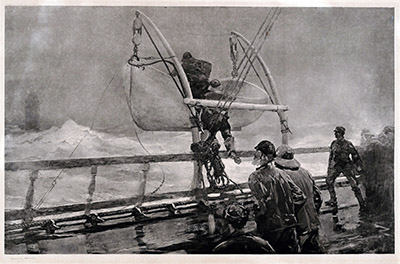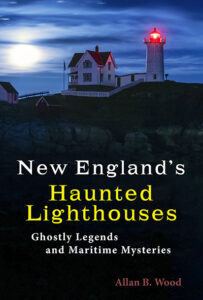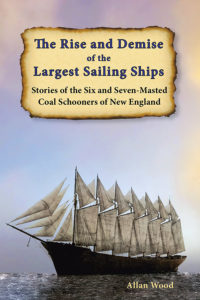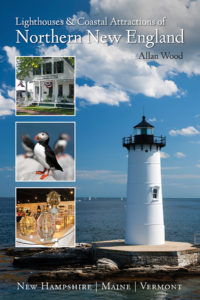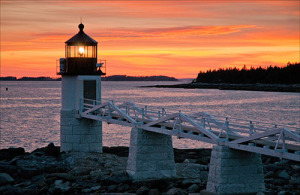Tragedy From an Axe Fight Aboard the “Queen” of All Wooden Sailing Ships, the Six-Masted Schooner, the Eleanor A. Percy
With the economic boom of the late 1890s, the need for coal, lumber, and steel for construction prompted shipbuilders to continue designing larger schooner sailing ships. These coal schooners, or colliers, were explicitly designed as bulk cargo ships to carry large quantities of coal or construction materials in one trip. Their unique sail design consisting of triangular and angular four-sided shaped sails gave these vessels unlimited range as they relied only on sail propulsion, although they depended on weather conditions. They were faster in deep open waters and were relatively inexpensive to operate, as they could be handled by smaller crews, saving the owners money on hiring sailors.
However, crew members hired on merchant ships came from all backgrounds. Some sailors came from different countries and would work for lower wages, saving the owners money. Many of these sailors were very young and came from poorly educated and low-income communities. These men spent many hours on the ship, not only sailing between destinations but also enduring the boredom of waiting to unload cargo or awaiting orders for the next charter to pick up the next load. Establishing a pecking order was expected, and bullying was always a part of the culture.
The Eleanor A. Percy slid into the waters on October 10, 1900, at the Percy & Small Shipyard in Bath, Maine. Being the second six-masted schooner ever built, she was initially scheduled to be launched before the George W Wells. However, the owners of the Wells wanted the notoriety of being first, so they launched the ship two months earlier using temporary masts to beat their competitor beforehand. The Eleanor A. Percy boasted a 323-foot-long hull with an overall length of 347 feet over the deck from stem to stern. She measured a breadth of 50 feet and could carry over 5,500 tons of cargo. She was the largest of all wooden schooners built then, referred to as the “queen” of all sailing ships, at a total cost of around $140,000 (today’s value would be $5,243,000). She was a heavy ship commanded by Captain Lincoln Jewett with a crew of fifteen men.
Vindictive Sailor Attacks Another With an Axe
A few years later, the giant six-master would have her first tragedy. On August 23, 1904, the Eleanor A. Percy was anchored off Castle Island Flats, a short distance from Deer Island Light and Long Island Head Lighthouse, and about a mile from Boston Harbor Lighthouse inside Boston Harbor, for a few days. She awaited the next charter for another cargo load from Norfolk, Virginia. Two sailors, William Phillips, aged nineteen, from Barbados, and Edward Murray, aged 22, got into a scuffle twice over a dice game dispute they were involved in before and after dinner. In both instances, Murray repeatedly struck Philips with a bottle on the shoulder and then on the head. Three other sailors were involved in the dice game, and after the second scuffle, Murray, the aggressor, was ousted from the competition.
Humiliated after being bullied in front of his peers, Phillips decided to teach Murray a lesson. He had previously hidden a small carpenter’s axe in a barrel in the engine room and waited until Engineer Charles Marks had left the room. He then retrieved the weapon and slid it down the leg of his trousers to conceal it. Cautiously, Phillips returned to his bunk and lay down, pretending to fall asleep while waiting for his moment to strike.
The men started playing another game of craps in their cabin, which continued until after 8:30 that evening. Phillips slowly retrieved the axe out of his trousers. Murray had his back turned to Phillips and had just started shaking the dice in their game when Phillips jumped out of his bed with the axe in hand and struck Murray in the neck, creating a deep gash. Blood was flowing everywhere as the victim dropped to the floor. The other sailors, shocked at the sight of the enraged Phillips and their comrade covered with blood, jumped up and ran onto the deck.
Phillips also had issues with one other member of the group, Oscar Newton, who had bullied him in the past. He chased Newton around the cabin and onto the deck, swinging his blood-covered axe. Newton started screaming for help, fearing for his own life as he tried to enter the captain’s empty cabin with Phillips close behind. Newton’s screams brought First Mate John Weylor, Second Mate John Edwardson, and Engineer Charles Marks to the deck. Weylor, seeing the dangerous situation unfolding, ran back to his cabin and grabbed his revolver. He then rushed up on deck and pointed it at Phillips, yelling at him to drop his weapon. The attacker dropped the axe as ordered, and Edwardson grabbed some rope and tied the young man’s hands and feet to secure him.
Edwardson returned to the incident scene and found Murray in a dire state but still breathing as blood gushed from his wound from the attack. He wrapped a towel tightly around Murray’s blood-covered neck as a temporary tourniquet to hinder the bleeding. Edwardson and Marks then jumped into a dory and rowed a relatively short distance to the harbor police station while the other crew members carefully watched Phillips. After finding Dr. Dunn and patrolmen Cross, O’Connor, and Carlson, they contacted an ambulance to prepare to take Murry to the nearby Boston City Hospital Relief Station.
Edwardson, Marks, the doctor, and the police returned to the ship on the Watchman, as the doctor prepped Murray and his wound. They returned to shore with Phillips and Edwardson and brought the three other sailors in the dice game back to the police station for further questioning.
Phillips told police that he assaulted Murray because he was the victim of assault first. However, he continued to incriminate himself when he described to the police the scheme he had planned on his aggressor. Phillips was then locked up for the night and charged with assault with a deadly weapon. The three other sailors were held in a separate cell until the next day to provide their side of the story as witnesses at the courtroom hearing. Edwardson returned to the ship that night as Captain Jewett was still ashore on business.
That morning on August 24, Phillips was arraigned and officially charged with assault with intent to murder. The judge scheduled him to appear in court on September 2, 1904. He was denied bail and detained at the county jail for fear of escaping. Around 4:00 p.m. that afternoon, Edward Murray died of his wounds, and the charges against Phillips had elevated to murder. He was convicted of the crime and was sentenced to life in a Massachusetts prison on November 25, 1904.
Nine years later, on November 22, 1913, Phillips, serving his life sentence, received a pardon from Massachusetts Governor Eugene Foss for good behavior. As a young prisoner, he had kept his cool, worked successfully in the shops, and shown remorse for his actions. Warden Bridges of the prison noticed his positive attitude and behavior. He made a personal recommendation to the Governor to commute his sentence, allowing him to be released early on November 28, 1913. However, the condition for the pardon was that Philips would return to his homeland of Barbados and never return to the United States, to which he agreed. The now older Phillips left on a steamer for Barbados, where he remained on the island with relatives. He eventually found work as a sailor and avoided any ports in the United States.
The Eleanor A. Percy continued transporting coal and construction materials, which was profitable for her owners. The giant six-master survived collisions, nasty storms along the East Coast, the Great Coal Strike of 1902, and even a coal tower fire that broke out while she anchored below. During the Great War, she also underwent an overhaul to carry petroleum. After nineteen years of service, she finally met her fate in December 1919 and sank during a storm off the coast of Ireland.
Books to Explore
New England’s Haunted Lighthouses:
Ghostly Legends and Maritime Mysteries
Discover the mysteries of the haunted lighthouses of New England! Uncover ghostly tales of lingering keepers, victims of misfortune or local shipwrecks, lost souls, ghost ships, and more. Many of these accounts begin with actual historical events that later lead to unexplained incidents.
Immerse yourself in the tales associated with these iconic beacons!
The Rise and Demise of the Largest Sailing Ships:
Stories of the Six and Seven-Masted Coal Schooners of New England.
In the early 1900s, New England shipbuilders constructed the world’s largest sailing ships amid social and political reforms. These giants were the ten original six-masted coal schooners and one colossal seven-masted vessel, built to carry massive quantities of coal and building supplies and measured longer than a football field! This self-published book, balanced with plenty of color and vintage images, showcases the historical accounts that followed these mighty ships, like the axe fight between two sailors on the Eleanor A. Percy.
Available also from bookstores in paperback, hardcover, and as an eBook for all devices.

Book – Lighthouses and Coastal Attractions in Southern New England: Connecticut, Rhode Island, Massachusetts
Lighthouses and Coastal Attractions of Southern New England:
Connecticut, Rhode Island, and Massachusetts.
This 300-page book provides memorable human interest stories from each of the 92 lighthouses. You can explore plenty of indoor and outdoor coastal attractions, including whale-watching excursions, lighthouse tours, windjammer sailing tours, parks, museums, and even lighthouses where you can stay overnight. You’ll also find plenty of stories of hauntings around lighthouses.
Lighthouses and Coastal Attractions of Northern New England:
New Hampshire, Maine, and Vermont.
This 300-page book provides memorable human interest stories from each of the 76 lighthouses. It also describes and provides contact info for plenty of indoor and outdoor coastal attractions and tours. These include whale watching, lighthouse tours, unique parks, museums, and lighthouses where you can stay overnight. There are also stories of haunted lighthouses in these regions.
Copyright © Allan Wood Photography; do not reproduce without permission. All rights reserved.
Join, Learn, and Support The American Lighthouse Foundation
